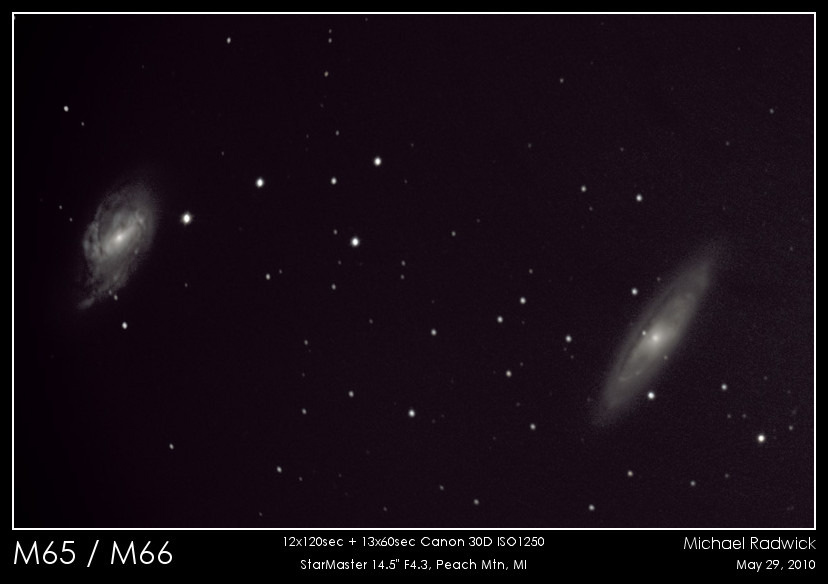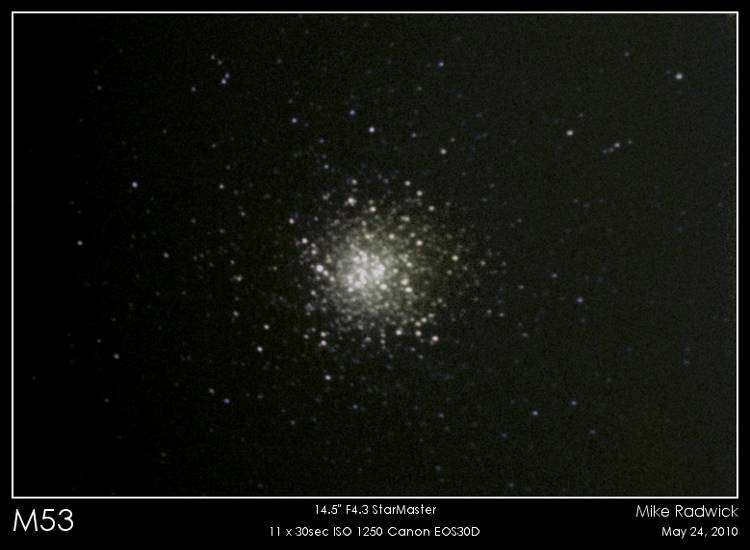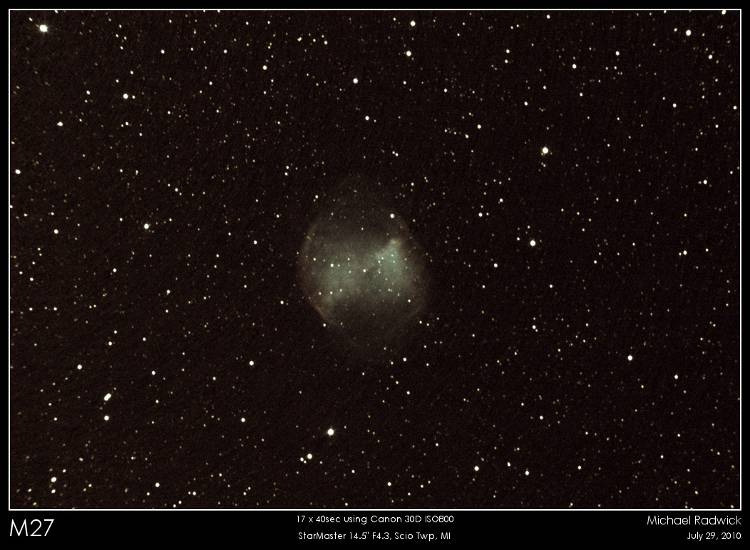


For Americans, this is the unofficial start of summer; the celebration involves beaches, picnics, and so on. Amateur astronomers “celebrate” the end of long cold nights and the start of mosquito-swatting. I celebrated by convincing Mark Deprest, Arthur Suits, and Chris Sarnecki to accompany me to Peach Mountain only three days after full moon. Hence we had only an hour or so of dark skies. Everyone had their favorite objects to chase.
No one would be surprised to learn that Mark spent his time hunting three comets (yes, he found all three)!
For some time I have been writing software that will interface my StarMaster telescope with a laptop computer. The computer can then run additional software using my interface that will allow auto-guiding (a process that allows the computer to control the telescope so that it stays pointed at the same object with a high degree of precision). The goal is to obtain the ability to take deep-sky photos with relatively inexpensive equipment. I have been testing the software on almost every night out since last summer. But the testing requires only a couple of short images in the field, and a lot of debugging back at my home. So the images I’ve taken never really revealed the deep-sky.
I now feel my interface is working well, so I wanted to spend my time this weekend taking my first “long” exposure astro- photograph. Since the telescope is an Dobsonian design (axis rotates left/right and up/down with respect to the local horizon), the field of view in the telescope will rotate over time. So “long”, that is the maximum time I can leave the camera shutter open without recording rotation, is dependent (partially) on the position of my target. Detail is acquired by taking many images and stacking them later on. Rotation is minimized for targets relatively low in the East or West; allowing for longer exposure times. But how long could I image before rotation was apparent? There is a arithmetic solution to that question, but I have yet to crunch the numbers; I prefer a experimental solution. I know from past experience that 1 minute exposures are no problem. I decided to try two sets; the first would be 15 one-minute exposures. My second set, following a rule set (mostly in jest) by some dear friends, is to “double it”. That is, I took as many two minute images as I could in the time left before the moon came up.
With that in mind, I chose M65/M66 to image. The galaxies position at 10:00pm EDT was 222 degrees Azimuth and 54 degrees Elevation. Moonrise was set for 11:03pm, giving me maybe an hour to image. By that time the galaxies moved to 240 deg. Az. and 46 deg. Alt.
These galaxies are moderately bright (AstroPlanner lists them as Mag 10.5 and Mag 10, respectively; SEDs lists them as 9.3 and 8.9), and not too spread out (M65 is 8x1.5 arcminutes and M66 is 8x2.5 arcminutes). They are close enough to observe in the same field of view with my scope, and are thought to be interacting with each other. The distance to these galaxies is about 35 Million Light-Years.
Good astro-photography requires good seeing. Poor seeing smears the image and prevents the capture of fine detail. The daytime temperature was in the upper-80s (F). After a hot day the atmosphere cools quickly which usually creates turbulence, so I did not have much hope for steady seeing; but as luck would have it, the seeing was very good. The resulting image was somewhat better than I expected.
Here is what I ended up doing:
For guiding I used a Meade Deep-Sky-Imager (DSI) camera in a Williams Optics 66mm telescope piggybacked on the StarMaster. The telescope was guided using free software called PHD-Guiding and controlled with my own software. I used an unmodified Canon 30D DSLR camera set at ISO1250 with a correcting lens (called an OCS) from Denkmeier Optical at the prime-focus of my StarMaster 14.5 F/4.3.
I took 15 one-minute images, 20 two-minute images, and 5 two-minute dark-frames. The Canon was controlled by another free program called DSLR-Shutter, written by the same guy who wrote PHD-Guiding (Stark Labs). Once the set was started I had nothing to do but sponge off of Mark, Art, and Chris for views of the sky. I’m really glad they were good sports about it (and for putting up with the light-pollution from my computer).
The next day, I stacked the images using software called Deep-Sky-Stacker. Two of the one-minute images where thrown out; some satellites passed through them leaving a long streak (maybe someday I’ll learn to erase such imperfections before stacking). Seven of the two-minute images were thrown out, these had out-of-round stars that were probably caused by a slight breeze shaking the scope and occasional overcorrection by the guiding system.
Final processing was done in Photoshop, but only minimal touch up has been done. Basically I cropped the image, then enhanced the contrast a bit to show the details. There are a lot more things I could try with this image, but I am still unskilled in this. Image processing can take many hours (in this case however, I spent maybe 1/2 hour on it). Coverage of I what little I know would require a whole separate article, and there are others in the club who know much, much more that I do on this subject. I’ll leave that for the future.

